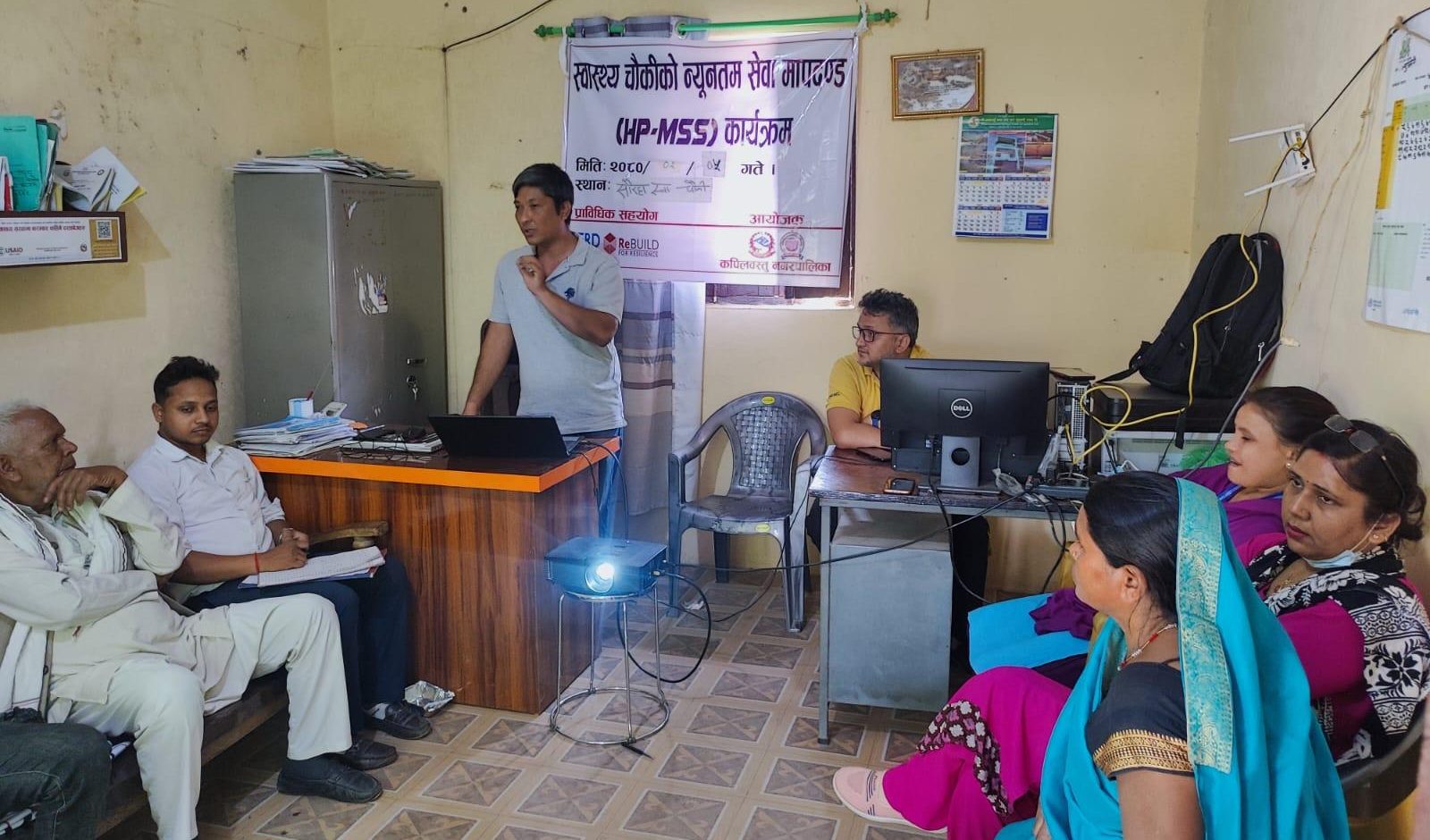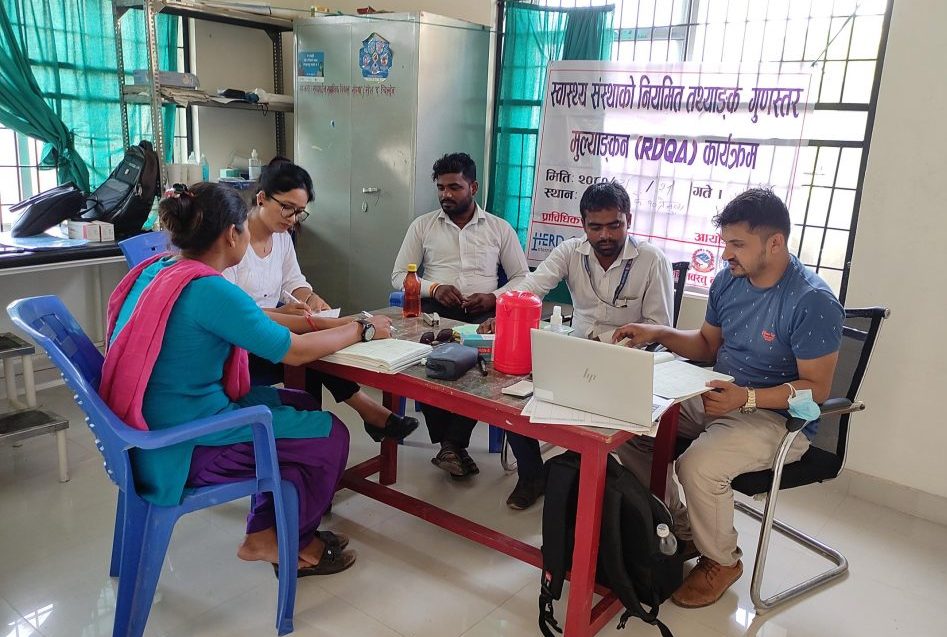
Health Facility Operation and Management Committees and their significance in local health governance in Nepal
16 April 2024
By Anil Dhungana, Shophika Regmi and Shreeman Sharma of HERD International
Nepal has undergone a significant transformation in its governance structure, moving from a unitary to a three-level federal system (federal, provincial, and local government levels), offering new possibilities for development, especially in healthcare. The division of legislative and executive powers for these three levels of government offers potential to address disparities in access to health care and the enhancement of overall health outcomes. Specifically, devolution of decision-making powers to the local level has provided ample opportunity to develop a nuanced understanding of health challenges, to set priorities and seek effective solutions.
The Health Facility Operation and Management Committee (HFOMC) is a legitimate body formed locally at each health facility, intended to govern all the affairs of local health facilities. The Health Facility Operation and Management Committee – A reference guideline for local level outlines the composition of the committees, their responsibilities, and the overarching goal of delivering effective health services while ensuring accountability and transparency in daily management functions from health facilities. However, formation of HFOMCs, as per the guidelines, and their effective operationalization has remained a challenge since the country was federalized. At HERD International, we are engaged in strengthening the local health system and building resilience capacity through the ReBUILD for Resilience project. As part of our interventions, we are working in partnership with Kapilvastu Municipality to strengthen the HFOMCs. This blog post presents our approaches and the learnings.
Composition and the role of HFOMCs
Guiding principles
One essential aspect of the healthcare decentralization process is the formation and functioning of HFOMCs. The efficacy of a health facility relies greatly on the good management, diligent monitoring, and thorough supervision conducted by the HFOMC. Acknowledging the crucial role of community engagement in supervising local health facilities and services, and adhering to the guidelines outlined in the Local Self-Governance Act of 1999, the Ministry of Health and Population (MOHP) has handed over the administration of health facilities to local levels as part of the decentralization policy. Under this provision, HFOMCs are tasked with overseeing all aspects of local health facilities. After federalisation and the Local Government Operation Act, 2017, the responsibility for health activities has fallen to the local government, and the role of the HFOMCs and elected representatives has increased even more.
Committee composition
The HFOMC, established locally at each health facility, is designed to be inclusive in its structure. According to the guidelines, the mayor of the municipality serves as the patron, the ward chairperson serves as the chairperson and the Health Facility In-charge serves as the member secretary of the committee. Also, the seven member committee comprises an elected female ward representative, local headmaster, ward secretary, representative of the business community and a Female Community Health Volunteer representative from the ward. The elected female representatives serve as the vice-chair of the committee (there is an elected male if the ward chair is female). Additionally, three members are nominated as invitee members, which includes one representative from the adolescent, elderly & disabled and ethnic and Dalit communities.
Roles and responsibilities
The HFOMC is responsible for overseeing all aspects of a health facility to ensure its smooth operation and to improve local people’s access to healthcare services. The formation and functioning of the HFOMC, the understanding of its members regarding their roles and responsibilities, and the extent to which they fulfil them is crucial to this. The functions of the HFOMC as outlined in the guidelines include:
- Ensure the availability of physical infrastructure, medicines, health personnel and health equipment in health institutions
- Ensure the protection and regular maintenance of physical assets of health institutions
- Carry out necessary coordination activities and ensure the quality of service flow
- Take the initiative to create a local health plan based on evidence
- Strengthen local health governance and ensure social accountability of the health facility through social audit, financial audit and public hearing of the health facility
- Ensure access of the local communities to health services
- Communicate and coordinate with the health section of the respective local levels in matters related to the operation and management of health institutions
- Formulate the necessary policies, plans and programs related to the progress and development of the health facility and implement them effectively
- Set annual targets for the health facility and review the implementation and achievement of annual programs conducted by the health facility
Current status of operation and challenges
Empowering local governments to allocate resources based on community needs can result in more efficient and targeted healthcare services. Despite the roles and responsibilities assigned to the HFOMC regarding health facility management, a majority of the committee members have inadequately fulfilled their duties. There have been instances where committee members were unaware of their roles and responsibilities, despite the orientation, resulting in ineffective functioning. Community participation is a vital component of the local healthcare system, helping to identify local needs, but their participation in the planning, implementation, and monitoring of health activities within the facility has been minimal. The ward chairs, who serve as the committee chairpersons, hold financial authority at the ward level but rarely engage with health facilities to address their issues. The relationship between chairperson and the committee’s member secretary (ward chair and health facility in-charge) significantly influences resource allocation for health facilities via the HFOMC, as well as the committee’s overall effectiveness. The main reasons for not having regular meetings included the feeling that there were no issues to discuss, busy schedules of members, especially the ward chair, and meetings not being called by the health facility in-charge who had the secretarial responsibility. There is a lack of concern from other members of the HFOMC regarding the irregularity of meetings and the reluctance of the chair and secretary to hold meetings. This lack of attendance and engagement of the HFOMC members hindered the effective implementation of health initiatives and opportunities for community participation in decision-making.
The activity level of the HFOMC depends on the priority accorded to the health facility by the ward chair, and the delegation of other committee members to oversee health facilities and monitor their activities. Mostly, the HFOMC members visit the health facilities if the committee meeting is called, rather than for quality assurance, supervision, and support. Despite the date for the meeting being fixed by the health facilities, the meeting is held on a date convenient for the health facility in-charge and the ward chair. The committee is inclusive and endeavours to bring forth issues for discussion from the communities they represent. However, it is predominantly the member secretary of the committee, i.e. the health facility in-charge, who forwards the discussion agendas.
Even though committee meetings are irregular, HFOMC members meet at health facilities during certain events, such as the follow-up sessions for Health Post Minimum Service Standard assessments and social audits (if planned by the municipality). During these gatherings, they collaborate to prepare action plans addressing the deficiencies identified during the assessments, aiming to improve healthcare provision at the facilities. The action plans are formulated through discussions among the members, reaching a consensus with the assistance of facilitators. Some of the health facilities with funds in the HFOMC account organize regular meetings to strategize the allocation of resources to address facility needs based on the action plan. However, the follow-up on these action plans during committee meetings appears to be lacking at the majority of health facilities. Some of the health facilities convene the HFOMC during the Annual Work Plan and Budget process, planning the needs of the health facility and making recommendations to the ward committee with regard to budget prioritization. But most of the health facilities do not have the meeting before this annual process, and nor does the ward meet with the health facility to discuss their needs.
Moreover, there were instances when key stakeholders, such as the mayor, Chief Administrative Officer, and the health section, who play significant roles in decision making at the ward level, did not prioritize healthcare in their planning and budgeting, instead focusing on physical infrastructure and other visible developments. This lack of attention and accountability by the ward towards crucial sectors has had a direct impact on the quality of healthcare services delivered to the community. The inactivity of the committee can be attributed to inadequate monitoring, guidance, and directives from key stakeholders within the municipality.
The way forward
The transition to a federal system of governance in Nepal offers immense potential for the national healthcare system. Decentralization allows decision-making authority to be vested in the hands of those who are closest to the communities they serve. This enables better alignment with local health needs. However, challenges persist in fully operationalizing the HFOMC at all levels and most of the health facilities do not have regular committee meetings and actions. There are steps which can be taken to address this.
Health facility in-charges, who as the member secretaries of the committees have responsibility for calling the HFOMC meetings, have a crucial role to play here. Including HFOMC meetings as one of the evaluation criteria for ranking health facilities during annual health reviews and providing merit points on the performance appraisal of health facility in-charges are essential in prompting health facilities to conduct regular HFOMC meetings.
Consistent follow-up from the health section, including the Chief Administrative Officer, is also necessary to ensure the regular occurrence of these meetings. Elected officials, particularly the mayor and the deputy mayor, should seek commitment from the ward chairs on this, and as a patron of the committee the mayor should also conduct frequent monitoring to ensure meeting regularity. The regular convening of HFOMC meetings should also be integrated into the evaluation criteria for each ward.
In addition, increasing awareness of committee members’ roles, particularly the ward chair, will help ensure active participation, while prioritizing budget to the healthcare sector is crucial to optimizing the benefits of federalism.
This article was originally published on the HERD International website [opens new tab]
